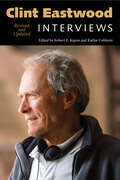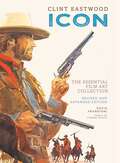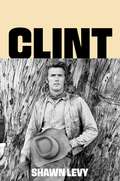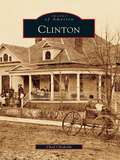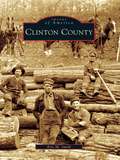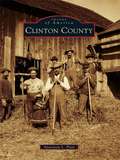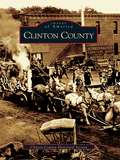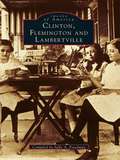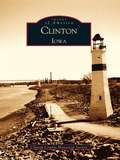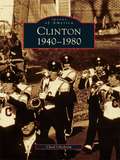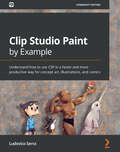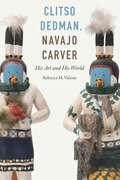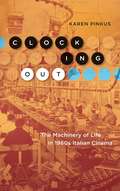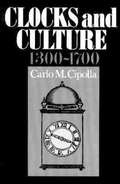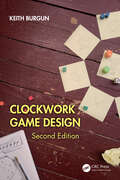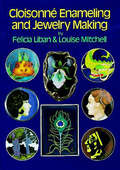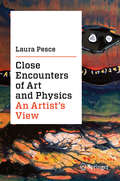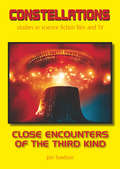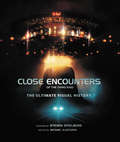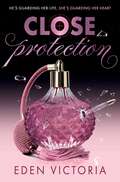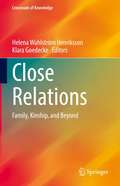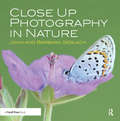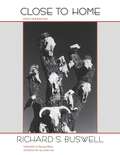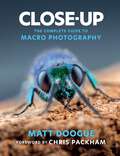- Table View
- List View
Clint Eastwood: Interviews, Revised and Updated (Conversations with Filmmakers Series)
by Robert E. KapsisClint Eastwood (b. 1930) is the only popular American dramatic star to have shaped his own career almost entirely through films of his own producing, frequently under his own direction; no other dramatic star has directed himself so often. He is also one of the most prolific active directors, with thirty-three features to his credit since 1971. As a star, he is often recalled primarily for two early roles—the “Man with No Name” of three European-made Westerns, and the uncompromising cop “Dirty” Harry Callahan. But on his own as a director, Eastwood has steered a remarkable course. A film industry insider who works through the established Hollywood system and respects its traditions, he remains an outsider by steadfastly refusing to heed cultural and aesthetic trends in film production and film style. His films as director have examined an eclectic variety of themes, ranging from the artist's life to the nature of heroism, while frequently calling into question the ethos of masculinity and his own star image. Yet they have remained accessible to a popular audience worldwide. With two Best Director and two Best Picture Oscars to his credit, Eastwood now ranks among the most highly honored living filmmakers. These interviews range over the more than four decades of Eastwood's directorial career, with an emphasis on practical filmmaking issues and his philosophy as a filmmaker. Nearly a third are from European sources—several appearing here in English for the first time.
Clint Eastwood: The Essential Film Art Collection
by Insight EditionsFeaturing rare, outstanding additional content, Clint Eastwood: Icon is the definitive collection of film art and material representing Clint Eastwood&’s legendary career as seen through the original iconic artwork.Clint Eastwood is a nameless vigilante, a vengeful detective, a bare-knuckle boxer, a Secret Service agent, and countless other definitive screen archetypes now embedded in our shared pop-culture consciousness. However you define him, Clint Eastwood has a powerful and extremely recognizable image that exists as something beyond the narratives of his films. Featuring a wealth of additional content, this new edition of Clint Eastwood: Icon presents an unprecedented collection of film art and rare material surrounding the legendary actor. This comprehensive trove gathers together poster art, lobby cards, standees, Italian Spaghetti Western Premier posters, studio ads, and esoteric film memorabilia from around the world. From his early roles as the nameless gunslinger in Sergio Leone&’s spaghetti Westerns, to the vigilante films of the 1970s and 1980s, through his directorial roles and latest releases, Clint Eastwood: Icon captures the powerful presence that turned Eastwood into the definitive American hero.
Clint: The Man and the Movies
by Shawn LevyA Los Angeles Times "Must Read Book for Summer""This is the biography of Clint Eastwood we've been waiting for." — Sir Christopher Frayling, author of Sergio LeoneFrom the acclaimed film critic and New York Times bestselling biographer of Paul Newman, a revelatory portrait of Hollywood legend Clint Eastwood, the most prolific and versatile actor-director in movie history and an imposing icon of American culture for six decades.C-L-I-N-T. That single short, sharp syllable has stood as an emblem of American manhood and morality and sheer bloody-minded will, on-screen and off-screen, for more than sixty years. Whether he’s facing down bad guys on a Western street (Old West or new, no matter), staring through the lens of a camera, or accepting one of his movies' thirteen Oscars (including two for Best Picture), he is as blunt, curt, and solid as his name, a star of the old-school stripe and one of the most accomplished directors of his time, a man of rock and iron and brute force: Clint.To read the story of Clint Eastwood is to understand nearly a century of American culture. No Hollywood figure has so completely and complexly stood inside the changing climates of post–World War II America. At age ninety-five, he has lived a tumultuous century and embodied much of his time and many of its contradictions.We picture Clint squinting through cigarillo smoke in A Fistful of Dollars or The Good, the Bad and the Ugly; imposing rough justice at the point of a .44 Magnum in Dirty Harry; sowing vengeance in The Outlaw Josey Wales or Pale Rider or Unforgiven; grudgingly training a woman boxer in Million Dollar Baby; and standing up for his neighbors despite his racism in Gran Torino. Or we feel him present, powerfully, behind the camera, creating complex tales of violence, morality, and humanity, such as Mystic River, Letters from Iwo Jima, and American Sniper. But his roles and his films, however well cast and convincing, are two-dimensional in comparison to his whole life.As Shawn Levy reveals in this masterful biography—the most complete portrait yet of Eastwood—the reality is richer, knottier, and more absorbing. Clint: The Man and the Movies is a saga of cunning, determination, and conquest, a story about a man ascending to the Hollywood pantheon while keeping one foot firmly planted outside its door.
Clinton
by Chad ChisholmClinton, Mississippi, is the home of Mississippi College, the state's oldest existing institution of higher learning. Clinton produced statesmen such as Walter Leake, writers and artists such as Barry Hannah and Wyatt Waters, and modern celebrities such as Lance Bass and Mandy Ashford. Today Clinton serves as a bedroom community for Jackson. Clinton began as the Mount Dexter trading post on the Old Natchez Trace. The town was founded as Mount Salus in 1823 by Walter Leake, one of Mississippi's first U.S. senators and the third governor. Six years later, Clinton fell one vote short of becoming the state capital. Through antebellum prosperity, occupation by Union troops, rebirth as a college community, and growth into a postwar suburban center, Clinton and its people have been marked by independence. This pictorial history is a chronicle of Clinton's most indelible individuals, families, and institutions.
Clinton County
by Eric M. SmithClinton County was originally inhabited by the Shawnee, Lenape, and Iroquois tribes. Lumber was abundant, and it drew in settlers searching for a home and work. A diversity of industry developed as people settled in the area, from brickwork in Farrandsville and Mill Hall to the heyday of the Piper Cub and Piper Aviation. During 1889, 1918, 1936, and 1972, floods tore through the county beforea levee system was finally constructed in Lock Haven in the 1990s. Education has been an important mainstay in the area, and one-room schoolhouses once dotted the landscape. The Central State Normal School, now Lock Haven University, was a regional draw for those seeking a career in teaching. Through historic photographs, Clinton County illustrates the changes that have occurred in this area over the years and traces the history of the people who created this heartland Pennsylvania community.
Clinton County (Images of America)
by Anastasia L. PrattFirst permanently settled after Samuel de Champlain's voyages through the region and officially chartered in 1788, Clinton County offers a host of agricultural and industrial pursuits. With a rich military history, the county was pivotal in the American Revolution as the birthplace of the U.S. Navy. Life in the county has been greatly enhanced by strong family traditions, religious celebrations, and social justice movements like the Underground Railroad. Clinton County is home to the city of Plattsburgh, the towns of Altona, Au Sable, Beekmantown, Black Brook, Champlain, Chazy, Clinton, Dannemora, Ellenburg, Mooers, Peru, Plattsburgh, Saranac, and Schuyler Falls, and the villages of Champlain, Dannemora, Keeseville, and Rouses Point.
Clinton County (Images of America)
by Clinton County Historical SocietyBefore settlers first arrived in the 1800s, Clinton County rested full of promise along the western edge of the Mississippi River. In the years that have passed, it has become an area of great commercial, agricultural, and industrial accomplishments. From the initial settlement of Lyons, DeWitt, and Camanche, where axe and oxen were prevalent on the scene, to the modern communities that are now home to astronauts and artisans, this book illustrates the incredible growth that has occurred over nearly two centuries. Through over 200 historical photographs, the Clinton County Historical Society documents how Clinton County has become a national treasure of culture and character.
Clinton, Flemington, and Lambertville (Images of America)
by Sally A. FreedmanLife among the rolling hills of northwest New Jersey and in the three small towns that became centers of that area's population has been faithfully recorded by residents since the Civil War, capturing the rural character of their landscape. The rich heritage of descendants of English, Dutch, and German settlers in the Hunderton County population centers of Clinton, Flemington, and Lambertville is presented here.
Clinton, Iowa (Images of America)
by Clinton County Historical SocietySince settlers first touched upon its shores in 1835, the city of Clinton, Iowa has evolved from a humble trading post on the Mississippi River into a vibrant city of thriving commerce, majestic homes, and riverfront splendor. Once the largest lumber milling center in the world, Clinton has long possessed a rich cultural heritage and a pioneering spirit. This book documents and explores the history of this proud community through a unique collection of historical photographs.
Clinton: 1940-1980 (Images of America)
by Chad ChisholmIn 1940, the town of Clinton had scarcely grown in size or population since the Civil War. However, the coming of World War II forever changed the identity of this small Southern college town. Aside from the sudden departure of its best and brightest men and women for the front lines, global war touched Clinton in the form of a German POW camp and a Navy V12 training school at Mississippi College. Clinton: 1940-1980 picks up where author Chad Chisholm ended his previous book, with Clinton in the midst of postwar growth. It is a chronicle of Clinton's living history, a treasury of photographs for all Clintonians.
Clip Studio Paint by Example: Understand how to use CSP in a faster and more productive way for concept art, illustrations, and comics
by Ludovico SerraGet up to speed with the essential tools and workflows for creating a professional portfolio using Clip Studio PaintKey FeaturesExplore the different art tools available for creating your own illustrations, comics, and animationsLearn how to make best use of Clip Studio Paint by implementing it in real-world scenariosUse Clip Studio Paint to leverage your artistic skills and create a portfolioBook DescriptionClip Studio Paint is powerful art software that can help you create artistic work with its in-built material organizer, 3D integration, and group work features. It also provides other features that can speed up the workflow of illustrators, concept artists, and comic artists. With Clip Studio Paint by Example, you'll learn how to use CSP effectively for a wide variety of artistic purposes. The book starts by helping you create the right workspace for concept art, illustration, and comics. You'll create a brush, set up a canvas, and develop an auto-auction. Along with covering how to work with CS Modeler that comes bundled with CSP, this book shows you how to import and rig characters easily. You'll then create reusable changeable scenes and a 3D human character in Blender before exploring concept art, illustrations, comics, and how to create your own portfolio. The book features a glossary with brief explanations of all the main CSP functions. The focus of the book is not on drawing or painting but on helping you enhance your artistic skills using Clip Studio Paint to create an impressive portfolio. By the end of this book, you'll be able to use the impressive capabilities of CSP to create beautiful digital art in a productive way.What you will learnExplore Clip Studio Paint and its use casesBecome familiar with the Clip Studio ecosystem for solving your artistic problemsImplement the CS Modeler and import and rig characters easilyCreate reusable and editable scenes and props using CS ModelerBuild a 3D human character using the Blender softwareSet up your workspace using CSP toolsCreate portfolios for your comics, illustrations, and concept artWho this book is forThis Clip Studio Paint book goes beyond the technical stuff that helps beginner-level as well as intermediate artists who are new to working in a digital environment and need a more streamlined and seamless workflow relating to illustrations, concept art, and comics in Clip Studio Paint. No prior knowledge of Clip Studio Paint is required to get started with this book.
Clitso Dedman, Navajo Carver: His Art and His World
by Rebecca M. ValetteRebecca Valette&’s Clitso Dedman, Navajo Carver is the first biography of artist Clitso Dedman (1876–1953), one of the most important but overlooked Diné (Navajo) artists of his generation. Dedman was born to a traditional Navajo family in Chinle, Arizona, and herded sheep as a child. He was educated in the late 1880s and early 1890s at the Fort Defiance Indian School, then at the Teller Institute in Grand Junction, Colorado. After graduation Dedman moved to Gallup, New Mexico, where he worked in the machine shop of the Atchison, Topeka, and Santa Fe Railway before opening his first of three Navajo trading posts in Rough Rock, Arizona. After tragedy struck his life in 1915, he moved back to Chinle and abruptly changed careers to become a blacksmith and builder. At age sixty, suffering from arthritis, Dedman turned his creative talent to wood carving, thus initiating a new Navajo art form. Although the neighboring Hopis had been carving Kachina dolls for generations, the Navajos traditionally avoided any permanent reproduction of their Holy People, and even of human figures. Dedman was the first to ignore this proscription, and for the rest of his life he focused on creating wooden sculptures of the various participants in the Yeibichai dance, which closed the Navajo Nightway ceremony. These secular carvings were immediately purchased and sold to tourists by regional Indian traders. Today Dedman&’s distinctive and highly regarded work can be found in private collections, galleries, and museums, such as the Navajo Nation Museum at Window Rock, the California Academy of Sciences in San Francisco, and the Arizona State Museum in Tucson. Clitso Dedman, Navajo Carver, with its extensive illustrations, is the story of a remarkable and underrecognized figure of twentieth-century Navajo artistic creation and innovation.
Clocking Out: The Machinery of Life in 1960s Italian Cinema
by Karen PinkusAn original reflection on Italy&’s postwar boom considers potentials for resistance in today&’s neoliberal (dis)order What can 1960s Italian cinema teach us about how to live and work today? Clocking Out challenges readers to think about labor, cinema, and machines as they are intertwined in complex ways in Italian cinema of the early &’60s. Drawing on critical theory and archival research, this book asks what kinds of fractures we might exploit for living otherwise, for resisting traditional narratives, and for anticapitalism. Italy in the 1960s was a place where the mass-producing factory was the primary mode of understanding what it meant to work, but it was also a time when things might have gone another way. This thinking and living differently appears in the cracks, lapses, or moments of film. Clocking Out is organized into scenes from an obscure 1962 Italian comedy (Renzo e Luciana, from Boccaccio 70). Reconsidering the origins of paradigms such as clocking in and out, &“society is a factory,&” and the gendered division of labor, Karen Pinkus challenges readers to think through cinema, enabling us to see gaps and breakdowns in the postwar order. She focuses on the Olivetti typewriter company and a little-known film from an Italian anthology movie, thinking with cinema about the power of the Autonomia movement, the refusal to work, and the questions of wages, paternalism, and sexual difference. Alternating microscopic attention to details and zooming outward, Pinkus examines rituals of production, automation, repetition, and fractures in a narrative of labor that begins in the 1960s and extends to the present—the age of the precariat, right-wing resentment, and nostalgia for an order that was probably never was.
Clocks and Culture, 1300-1700
by Carlo M. CipollaThe history of the clock opens a window on how different cultures have viewed time and on Europe's path to industrialization.
Clockwork Game Design
by Keith BurgunBy finding and building around a strong core mechanism, we can access new levels of elegance and discover fresh new ideas in our game designs.Clockwork Game Design is a functional and directly applicable theory for game design, particularly focusing on strategic and tactical games, but also more broadly applicable to many kinds of games. It details the Clockwork Game Design pattern, which focuses on building around a fundamental core functionality. You can then use this understanding to build a system of tools that helps a designer refine their rulesets. A game can achieve clarity of purpose by starting with a strong core, then removing elements that conflict with that core while also adding elements that support it.The Second Edition is filled with examples and exercises detailing how to put the clockwork game design pattern into use, this book is a helpful tool in the toolbox of game designers.Key Features: A hands-on, practical book that outlines a very specific approach to designing games Develop the mechanics that make your game great, and limit or remove factors that disrupt the core concept Practice designing games through the featured exercises and illustrations
Cloisonné Enameling and Jewelry Making
by Louise Mitchell Felicia Liban"The complete book on cloisonné enameling . . . encyclopedic in scope." -- Jewelers' Circular-Keystone"A good addition to all general craft collections." -- Library JournalOne of the most beautiful forms of enameling and jewelry making, cloisonné enameling is currently enjoying a renaissance among jewelers, enamelists, designers, and craftspeople. For anyone wishing to explore the age-old art, the present volume is considered the best book on the subject. Written by two veteran jewelry designers and widely acclaimed when first published, it offers a comprehensive step-by-step guide to the tools, materials, and processes required to create shimmering, gem-like cloisonné enamels and settings.The book is divided into two parts. The first conveys everything from designing the wirework for the "cells" or cloisons, making the enameling cup to hold the wires and enamels, and adding and firing the colors, to creating special effects with wire, foil, and decals. Part II provides clear directions for creating handsome settings for pendants, rings, pins, buckles, boxes, and a variety of other decorative items. Over 150 detailed illustrations and photographs illuminate each step of the procedures as well as the glorious finished products.This thorough, informative book will be appreciated by intermediate-level and advanced enamelers alike. It deserves a place on the bookshelf of anyone interested in the rewarding and highly satisfying art of creating vibrant multi-hued cloisonné enamels and jewelry.
Close Encounters of Art and Physics: An Artist's View
by Laura PesceClose Encounters of Art and Physics is a voyage in time through the abstract ideas harboured in the minds of humans, starting from the graffiti art of cave dwellers and extending to the street art of contemporary men and women. In seeking parallels with science, the author looks far back to the first geometric ideas of our ancestors as well as ahead to the contemporary science of present-day physicists. The parallelism and analogies between these two fields bear witness to a real entanglement in the human brain. The second part of the book contains about 25 colour images showing the author's stunning glass artwork representing ideas such as dark matter, quantum entanglement, cellular automata and many others that are almost impossible to capture in words. Furthermore, many of the physicists who have themselves made major contributions in these fields provide their comments and analysis of the works. The book provides entertaining and informative reading, not only for practicing artists and physicists, but also anyone curious about art and physics.
Close Encounters of the Third Kind
by Jon TowlsonFor many, Close Encounters of the Third Kind (CE3K) is not so much a movie as a religious experience. On its release in 1977, CE3K virtually redefined the science fiction film, shifting it away from spaceships, laser guns, and bug-eyed monsters into a modified form of science fiction that John Wyndham once called 'logical fantasy'. What would it be like if extra-terrestrials made contact with people on Earth? How would it feel? Like 2001: A Space Odyssey (1968), Steven Spielberg's primary inspiration, CE3K is concerned with mankind's evolution towards the stars, towards a state of transcendence. But Spielberg's vision hinges not so much on cool scientific intellect being the key to our next stage of evolution, as on the necessary development of emotional intelligence. To that end, we must regain our childlike curiosity for what lies beyond the skies, we must recover our capacity to experience wonder. Intensity of emotion is inherent to the film's meaning, and the aim of this book is to explore this in detail. Along the way it delves into the film's production history, explores Spielberg's remarkable cinematic realisation of the film (including a comparison study of the three different release versions), and considers in detail how CE3K fits into the Spielberg oeuvre.
Close Encounters of the Third Kind (Constellations)
by Jon TowlsonFor many, Close Encounters of the Third Kind (CE3K) is not so much a movie as a religious experience. On its release in 1977, CE3K virtually redefined the science fiction film, shifting it away from spaceships, laser guns, and bug-eyed monsters into a modified form of science fiction that John Wyndham once called 'logical fantasy'. What would it be like if extra-terrestrials made contact with people on Earth? How would it feel? Like 2001: A Space Odyssey (1968), Steven Spielberg's primary inspiration, CE3K is concerned with mankind's evolution towards the stars, towards a state of transcendence. But Spielberg's vision hinges not so much on cool scientific intellect being the key to our next stage of evolution, as on the necessary development of emotional intelligence. To that end, we must regain our childlike curiosity for what lies beyond the skies, we must recover our capacity to experience wonder. Intensity of emotion is inherent to the film's meaning, and the aim of this book is to explore this in detail. Along the way it delves into the film's production history, explores Spielberg's remarkable cinematic realisation of the film (including a comparison study of the three different release versions), and considers in detail how CE3K fits into the Spielberg oeuvre.
Close Encounters of the Third Kind: The Ultimate Visual History
by Michael KlastorinCelebrate the fortieth anniversary of Steven Spielberg’s sci-fi classic Close Encounters of the Third Kind with this fully authorized behind-the-scenes book exploring the creation, production, and legacy of this iconic film.Created in conjunction with Sony Pictures and Amblin Entertainment, Close Encounters of the Third Kind: The Visual History details the complete creative journey behind the making of the film and examines its cultural impact.Featuring rare and never-before-seen imagery from the archives, the book brings together a stunning collection of on-set photography, concept art, storyboards, and more to create a visual narrative of the film’s journey to the big screen. It also features a wealth of insightful commentary from every key player involved in the film, from the acclaimed director himself to the film’s stars and the key department heads who brought Spielberg’s vision to life.Special inserts and interactive elements include script pages, call lists, concept sketches, and more. Comprehensive, compelling, and filled with unseen treasures, Close Encounters of the Third Kind: The Ultimate Visual History is a fitting tribute to one of history’s most iconic films.
Close Protection: The thrilling #FakeDating #BodyguardRomance YA debut from BookTok Content Creator of the Year
by Eden VictoriaIT&’S. FINALLY. HAPPENING. The thrilling fake-dating, bodyguard romance YA debut from the original BookTok content creator of the year, Eden Victoria (@EdenVictorria and @edenslife) Being the heiress of Greenway Discoveries, Daphne Green has always lived a life of privilege. But when there is a break-in at her father&’s office, he enlists the service of Milosh Petrov to guard her as a precaution. Just a precaution . . . Assertive and straight-talking Milosh takes his job seriously: keep them safe and walk away. But when he&’s tasked with posing as a close protection officer for Daphne, walking away starts to feel impossible. And when the threat against her life becomes very real, Milosh vows to do whatever it takes to keep her safe.The perfect read for fans of Ana Huang, Jessa Hastings and Lauren Asher.
Close Relations: Family, Kinship, and Beyond (Crossroads of Knowledge)
by Helena Wahlström Henriksson Klara GoedeckeThis book speaks to the meanings and values that inhere in close relations, focusing on ‘family’ and ‘kinship’ but also looking beyond these categories. Multifaceted, diverse and subject to constant debate, close relations are ubiquitous in human lives on embodied as well as symbolic levels. Closely related to processes of power, legibility and recognition, close relations are surrounded by boundaries that both constrain and enable their practical, symbolical and legal formation. Carefully contextualising close relations in relation to different national contexts, but also in relation to gender, sexuality, race, religion and dis/ability, the volume points to the importance of and variations in how close relations are lived, understood and negotiated.Grounded in a number of academic areas and disciplines, ranging from legal studies, sociology and social work to literary studies and ethnology, this volume also highlights the value of using inter- and multidisciplinary scholarly approaches in research about close relations.Chapter 11 is available open access under a Creative Commons Attribution 4.0 International License via link.springer.com.
Close Up Photography in Nature
by John and GerlachCapturing the grandeur of landscapes or mood of a certain natural light is challenging but often the simple details of a texture or color evade photographers most of all. In Close Up Photography in Nature, best-selling authors and nature photography pros, John and Barbara Gerlach, share the tips and techniques necessary to successfully photograph the beauty all around you. The Gerlachs are celebrated teachers who understand a photographer's mind so they begin this book with a brief overview of the fundamentals before delving into some of the more advanced and unique challenges of close up photography. Topics covered include: advanced flash techniques specific for close up shooting, as well as a discussion on focus stacking strategies and tilt-shift lenses for getting maximum depth-of-field. The Gerlachs also discuss their strategy of mixing flash with natural light when shooting close up, which opens up all sorts of photographic possibilities – opening up shadows, creating shadows, separating the subject from the background, reducing contrast between the subject and the background, improving the color rendition, shooting sharper images, and much more. This book will change the way you see the world as well as the way you share it through your work! the world through your work!
Close to Home: Photographs
by Richard S. BuswellFor over four decades, Richard Buswell has trained his camera on the landscape of Montana, with its abandoned and overgrown homesteads and majestic, never-ending skies. In the recent work assembled in this volume, Buswell&’s fourth book, his subjects are much more than scattered remains. His black-and-white photographs frame cast-off, common things to reveal abstract patterns in the tradition of twentieth-century modernist photography. As Buswell puts it, his work is &“more interpretive and abstract than it is documentary. The images explore the junction where decaying artifacts become visual echoes of the past.&” To create a portfolio of images that make us look anew at the West requires a mix of courage and patience, of persistence and imagination. Richard Buswell has shown just these qualities as he has turned a youthful hobby into a powerful means for exploring the past and present of his Montana homeland.
Close-Up: The Complete Guide to Macro Photography
by Matt Doogue'Brilliant... Complete... Concise... Matt's innovative and imaginative approach makes celebrities and heroes out of the everyday, the downtrodden and the overlooked.' Chris Packham.Macro is one of the fastest-growing genres in photography, and with this comprehensive and easy-to-follow guide, macro expert Matt Doogue invites you to discover a whole new world of creative image-making.- Go from complete novice to confident macro shooter - Learn from a top professional sharing tips & tricks for success - Discover an exciting new genre of photographic practice - Connect with nature and develop a deeper understanding of wildlife - Master key techniques for pro-level macro photography results - Experience a more mindful approach to taking photosFrom understanding the optimal lens, to the shooting environment, advanced techniques and post-processing, unlock the beauty of the miniature world with this detailed guide.
